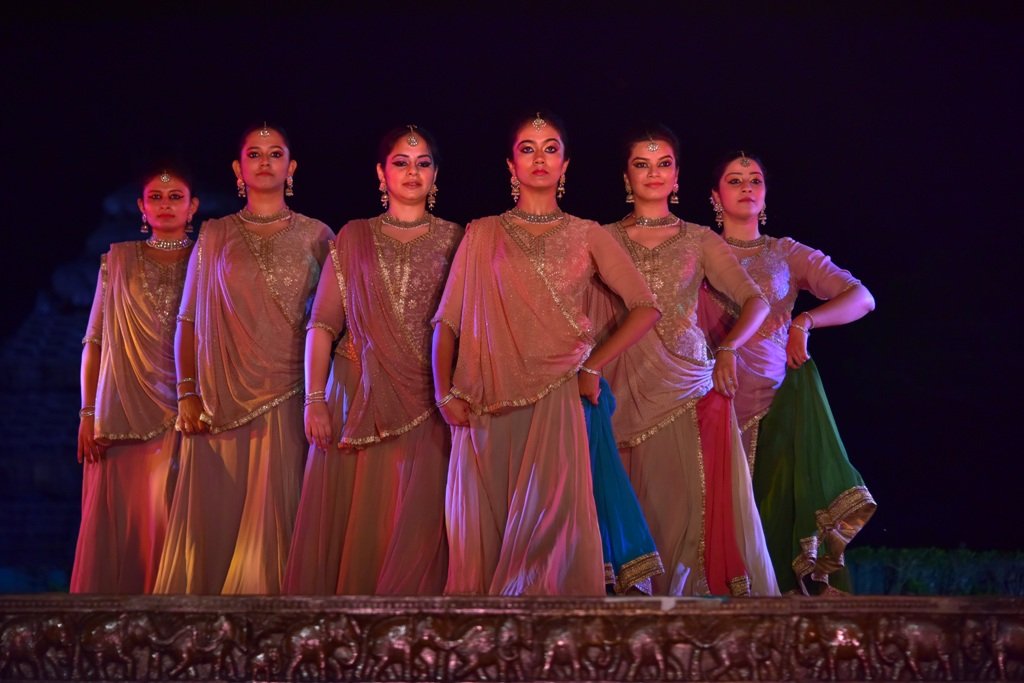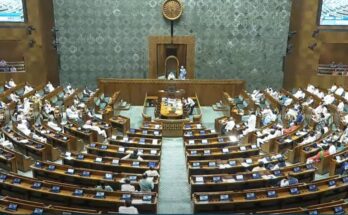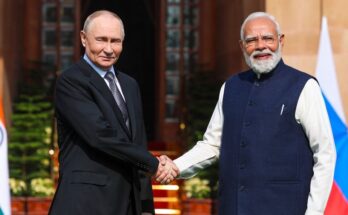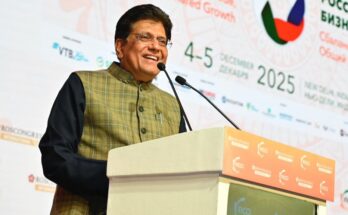By Leela Venkataraman
Having attended the Konark Festival over the last ten years or more, one realises that this event has assumed the state of being the signature festival of Odisha. While archaeological temple remains of ancient India have been used in several parts of the country as excellent backdrop for festivals of dance and music, signifying a coming together, not in a ritualistic, but a secular performance context, no other State has shown the undiminished and unswerving enthusiasm in developing these sites, as Odisha has of Konark.
From the extensive illumination of buildings and gardens, to the massive performance area, to the road leading to the performance site from the gate decorated with massive Rangoli designs, to the simultaneously held Sand Festival showing constant improvements at the site facilitating viewers visiting the spot, the State has worked at preserving the aura of an annual carnival – for a week turning the quiet and sleepy Konark township into a high profile arena of art beckoning tourists from afar and near. As part of the promotion drive for tourism, with art forms of Odisha treated as major part of the attraction for visitors dance has earned dividends in terms of an enlarging audience, though the fallout has the lurking potential for less favorable consequences too.
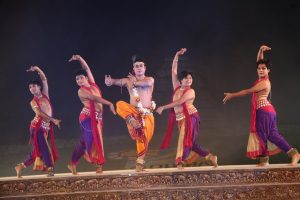
By making the festival a permanent annual event on the yearly Odisha culture calendar, the state has given the festival a permanence making it one of the major events for outsiders visiting India. While the state tourist trade has increased, there is always a delicate balance which the state government has to keep an eye on to ensure that too much of the cosmetic element does not spell other problems by making traditional arts a way of attracting tourist traffic
As a state sponsored event, the choice of groups done by a selection committee, has generally, over the years, been fair, barring a few cases – where eyebrows have been raised with unavoidable perceptions nursed of political considerations having overridden artistic criteria.
Along with the meticulous arrangements, and increasing magnificence of the performance arena, with the seating capacity also increased over the years, the inauguration ceremony seems to project more and more dignitaries with about ten to fifteen people on the stage for the lamp lighting, invoking Jagannath (installed with Balabhadra and Subhadra on the right side of the stage as one faces it, presiding over the performance platform as it were. What with the drone camera circling the sky, photographing the entire proceedings for a simultaneous DD Bharati broadcast, those who do not have the benefit of being present at the performance site, get to view it simultaneously.
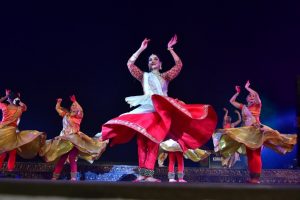
As the home of Odissi, that one half of every evening’s programme should constitute an Odissi group recital is in the fitness of things. From the local Odissi groups presented this year, Durga Charan Ranbir’s Nrutyayan acquitted itself with credit. Durgacharan as choreographer in Nirvana Shatakam,describing the non dual oneness of Chidanandaroopam “Shivoham Shivoham” comprising the realisation that Brahman is within oneself, uses Guru Debaprasad’s style with its minimalism and strong Chauka to excellent effect, based on libretto of Sanskrit scholar Nityanand Misra and music scored by Ramahari. The pallavi in Keerwani and in conclusion was the Samba Upakyana episode, wherein Samba cursed by Krishna to become a leper, for having trespassed into the intimacy of the latter’s bed chamber when he was with his Chief Queens Rukmini and Satyabhama, rids (as suggested by Narada) himself of the disease through concentrated prayer to the Sun God. This part through Hatha Yoga postures impeccably held by the very well balanced male dancers (Rahul Acahrya made an excellent Krishna with the sriingar sequences with his Chief eight queens, very well brought out) and with dramatic freezes one after the other portraying the Surya prayer. It was the crew of male dancers who enhanced the tone of presentation. Unlike the male costume, the female costume had too many clashing colours.
It was the concept of Sangita Gosain, now administrative head of the Kelucharan Mohapatra Odissi Research Centre, to create a full length dance drama based on Kishore Chandrananda Champu by Kavi Surya Baladev Rath – exploring the poetry/ musicality/ the Krishna Radha interaction, of the Champu – a genre so specific to music in Odisha. The production with too many choreographers (Nabakishore Misra, Yudhisthira Nayak and Lingaraj Swain) and perhaps dancers too from different organisations, lacked a unified look in the dance direction and for this critic, the vast stage space could have been better used. The finale of Jhoola and Shankarabharanam Pallavi, not part of the textual base, made a suitable end. The production, for an institution presiding over Odissi, needs to evolve in sophistication.
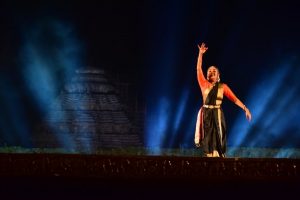
Refugee by Ileana Citarishti’s group based on the poems of Devdas Chhotray, and music by Laxmikant Palit, in an unending quest of linking traditional dance to contemporary realities, while laudable as a bold attempt at experimentation, in this context of the Konark festival, just did not click. To fill up an hour with the uncertainty of looking for a place one can call home, unless pegged on to something concrete becomes too abstract in dance.
In this context with Konark in the backdrop, the theme found no resonance. The concluding part with Ileana and Saswat Joshi in a duet based on Kalidas’ verse in Raghuvamsh of the Ganga and Jamuna, two rivers with different characters joining, with Gopalchandra Panda’s music and singing by his daughter, raised the comfort level of the audience for now they were on terrain they understood.
With male dancers in plenty, Odissi has been inducted with a new kind of energy, though it has injected a new need for awareness in preserving the ‘lalitya’ Odissi is known for. While male performers make technically strong dancers, one wishes they would introduce into their daily routine, exercises to lessen the flab round the region of the abdomen. Dancing with bare torsos, demands a physique which makes a difference to the total aesthetics.
The other aspect is how to manage sound in the open air area and the fashion it has become for unwieldy numbers of musicians in dance productions. Classical performances need evocative accompaniment — not orchestras. The open air disturbs the tonic of percussion and string instruments, which have to be constantly monitored. And having too many instruments, voices, and percussive tones, destroys sruti based rendition turning it into a cacophony. Having a larger number is not associated with quality. Almost all groups faulted in this regard.
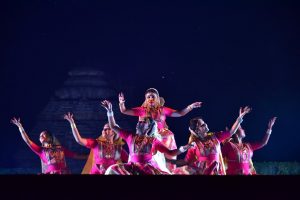
The Odissi performance, which in terms of conceptualisation and rendition, was best was by Odissi Vision and Movement Centre under Kolkata’s Sharmila Biswas. Finding the new in reviving some of the forgotten old treasures of art and literature from rural Odisha, the Sabda/ Swara/ Patha from Kumbha village was rendered by the dancers bringing out the energy of Shiva tandav and the sensuous grace of Parvati in a unhurried, savoured unfolding of movement, where just the pair of Krishnendu Saha with Monani and Rohini Banerjee, with three dancers forming a line on the side created visual poetry.
After the Patha, dancing nritta to a “Tam thai taka thai taka taka inda thai” refrain like a slow chanting was hauntingly effective. With uncut sarees tied kachha fashion round slim bodies, with minimal jewellery in the hair buns, there was a clean scrubbed look and sensuous feel to every move unencumbered by rich getup. Kalasri based on the raga (music composed by Denashish Sirkar) to which the dance was rendered portrayed the strongly etched Chauka the central concern of Odissi and how movement emerges from this base to expand in variety, with Dhaneswar Swain’s nritta contributions spun into the refrain “Jham tarita jena ta jhamta rita jena’’. It was quality by a small group which filled the stage. Mukta Mahari’s “Jooda bandhiro” wherein the singhar of the Mahari’s body concludes with the offering of the same body in sringar to Jagannath, was followed by ecstatic Moksha rendered to the sounds of the Ghanta Mardala. Contemporaneity lies in a deeper understanding of the old roots — often driven to the hinterland of memory.

The concluding day’s Odissi by Ranjana Gauhar’s Utsav group performed Matsya Avatar. To give more body to a very lean story of the Vedas being stolen by Hayagriva and rescued from the Seas during Pralaya by Vishnu as Matsya, Ranjana added a Pallavi and the “Om Narayana Matsya Narayana” chant with the dancers holding the Matsya pose. The text in a mix of languages had its Sanskrit verses ready in Jayadeva’s “pralaya prayodhijale…. The dancers performed in unison and the two male dancers as Hayagriva and Vinod Kevin Bachhan as Matsya, in Chau and Odissi movements, suited the roles.
The selection committee now has to tap younger choreographers with groups — the seniors being invited once in three years, makes it difficult to find choices of quality and the result is a mix of the excellence with mediocrity.
Kathak had two representative groups one from Chhattisgarh led by Yasmin Singh trained in the Lucknow gharana and later the Raigarh gharana, and Kumudini Lakhia the veteran Lucknow gharana Kathak Guru heading the well known institution Kadamb.
A neat effort with clean dancers who did not lack for ang and well executed chakkars, what the Chattisgarh group lacked was the part spelling the gravitas of classicism, and from the glittering costume and getup and the large group of accompanists for the music, it was apparent that what was intended was to create a spectacle. This enhancing for effect seemed to cut into the depth of traditional Kathak. Yasmin has for the first time tried to project Raigarh Gharana in a group identity – fit for the contemporary proscenium. But the item of Raja Chakradhar Singh the founder of the gharana she chose “Gori tere naina salore” made into a group spectacle, lost out on abhinaya, for which this composition describing the eyes so beautiful — one look hitting one like an arrow aimed at the quarry, is intended. And the inflated group of musicians in a ‘chorus’ had the same problem as others who went after numbers in the musical team.
Quite the opposite, the Kadamb group led by Sanjukta Sinha, dazzled with their classical virtuosity. If the female dancers had a classical elegance in teental or even 12 matra invocation, one has perhaps never been treated to bandishes in Dhamar taal (14 matras) rendered at such speed and with such clarity in chakkars and footwork by male dancers. And amidst excellence in nritta, presentational aesthetics was kept in mind. The “Barse Badariyan Savanki” saw some delightful images connected with the Monsoons like the peacock and then came the Tarana in Puryadhanashree which was immaculately rendered. But in all this crackling virtuosity, one aspect emerges with clarity and that is that Kathak is relegating abhinaya more and more into the hinterland. Group dancing does not mean that the emotive part of dance has to be totally sacrificed.
Bharatanatyam by Rama Vaidyanathan and group was most certainly one of the highlights of the festival. The first laudable point was having a small, perfectly balanced musicians, just four in number, for the music, led by dulcet voiced Sudha Raghuraman whose ecstatic melodies filled the open air space with delight. Dancers who moved with clean movements without distorting the Bharatanatyam profile, and Rama’s group designing which through fine ideas like bringing in unexpected changes in the group geometry, with a sudden insertion of a solo teermanam by Dakshina her daughter or a duet where she and another dancer came together, or a sudden turnaround switching on to a recitative mode from the melodic, kept the group interest alive and even well worn items were given a look that was not jaded. With Devi Stuti beginning with raga Rasikapriya with the beeja mantras ‘om aim hreem shreem’ moving on to Gaula, Surati, Hamsanandi and Revati showing powerful Devi as Rudraroopini and also in her grace giving benevolence and moving on to ‘Chal mana…” urging the devotees to go to Kashi to have a darshan of Vishwanath and the Ganga, had woven into the dance narrative episodes like the descent of Ganga with her high spirited turbulence getting controlled by Shiva when she is finally held captive in his locks, Shiva in his Tandav ecstasy, providing dramatic content. The finale of Balamurali’s Dwijawanti Tillana saw a fine rendition of dancers turned out in a simple but attractive orange coloured outfit contrasted by green blouses and minimum of jewellery. Not a note on Raghuraman’s flute or Biju Anand’s violin or Sumud Sreedharan’s mridangam went off key.
How one treats the traditional repertoire can also be very original. Which is what Kuchipudi dancer Sreelakshmy Govardhana, director of Avantika Space for Dance in Kerala, showed in her composition Soorpanakha. The Balamurali Kriti in Arabhi invoking Ganesh, Hanuman and Krishna rendered by the group was followed by the centerpiece on the Ramayana incident. Her own libretto with music composed by B.S.V. Sastry of Hyderabad in ragas like Charukesi, Vasanti, Vijayanagari, Mohanangi and Dhenuka provided the base for Soorpanakha, who in desolation looking at Lanka destroyed, her brother King Ravana killed and her tribe getting totally wiped out, asks in a mix of anger and sorrow as to what her sin was that she should have been thus deformed and rejected by the two princes Rama and Lakshmana. Was loving them and declaring that a sin? The youngest of the forest angels (while others move away after some sympathy for her) lies down with her head on Soorpanakha’s lap, showing her deep agony at what was meted out to this forest dweller. The abhinaya for the words was full of a moving intensity, demonstrating Sreelakshmy’s finesse as a dancer, as she finally poses the query “Na Dosham emi?” It was a women’s lib aroma right through.
The love aroused for the princes (portrayed with great abhinaya conviction) badly needed editing for the production presented in the open air and on such a vast space. And while the music providing artists were just four, Shyam Kalyan’s violin was made so loud that the voice of the melodious singer Murali Sangeet got totally drowned.
The invocation by the Sattriya group led by Anvesha Mahanta, proved how just two performers in Gayan/ Bayan with Khol and cymbals, Haiprasad Saikia and Devjeet Saikia could fill up the stage with their presence, with percussion expertise with the drummer combining hand movements with various hastas and feet moving to rhythm in typical Sattriya gait. Anvesha’s troupe of dancers, extremely tastefully attired in pink and white in the typical Assamese mode made a dreamlike entry from the extreme rear of the stage with the temple lights like rays of the Sun God with the temple at the back, bathing the dancers in glittering brightness. Starting with the meditative “Namo Namo Jagannatha” Kirtana from Sankaradeva’s Kirtana Ghosha, the rendition followed with Sali Nach, one of the most graceful dances in Sattriya. The centerpiece, which followed Dasha lakshana from the Bhagavata Purana, and the manner in which Sankaradeva communicated the principles governing the relationship between the Almighty and the devotee to the devotee, as captured in the dance, while entertaining, had too much of abstraction in the links not communicating fully to the audience. Thus while Creation with the five cosmic elements, the Gajendramoksha narrative, the Narasimhavatar and such segments were very clear, the connectivity in the lakshanas Sarga, Sthana, Manvantarra, Ishana, Nirankara –Akara, Poshana, Atmajnana, Uti, Ashraya, Mukti did not emerge with clarity in the rendition. But the pleasant dancing held the audience. The music, with the Khol percussion went with the dance and was not over powering.
The two comperes Sadhana Srivastava and Mrityunjay Rath, vibed well – his Oriya eloquence contrasted and complemented by her information in an English/ Hindi blend.

